The full text contains3058 words, reading time approximately5 minutes
-
According to the “2019 Annual Report on the Top 100 Chinese Catering Enterprises and Analysis of the Top 500 Catering Stores” released by the China Cuisine Association, optimizing restaurant cost structures and reshaping the catering industry chain have become issues that more and more practitioners in the catering industry are beginning to consider after the pandemic.
-
The setup of robot restaurants, which is “unmanned and contactless,” meets the demand for “hygiene and isolation” during dining in the pandemic while reducing labor costs, providing new ideas for the development of the catering industry after the pandemic.
Written by Xu Yin
Imagine a new dining experience in a smart robot restaurant:
Customers enter the restaurant and are guided to their respective tables by robots; after sitting down and scanning a code to order food, dishes are delivered via a conveyor belt to the corresponding robot for preparation; once the dishes are ready, they descend from the “sky” via a cloud track installed in the restaurant; during this time, delivery robots bring side dishes to customers; after the meal, if they want ice cream, they can scan a code to have the ice cream robot make a cone…
On the morning of June 22, the robot restaurant complex under Country Garden Group officially opened in Shunde, Guangdong. This is another robot restaurant opened by Country Garden Group after testing the waters in Guangzhou in January 2020.
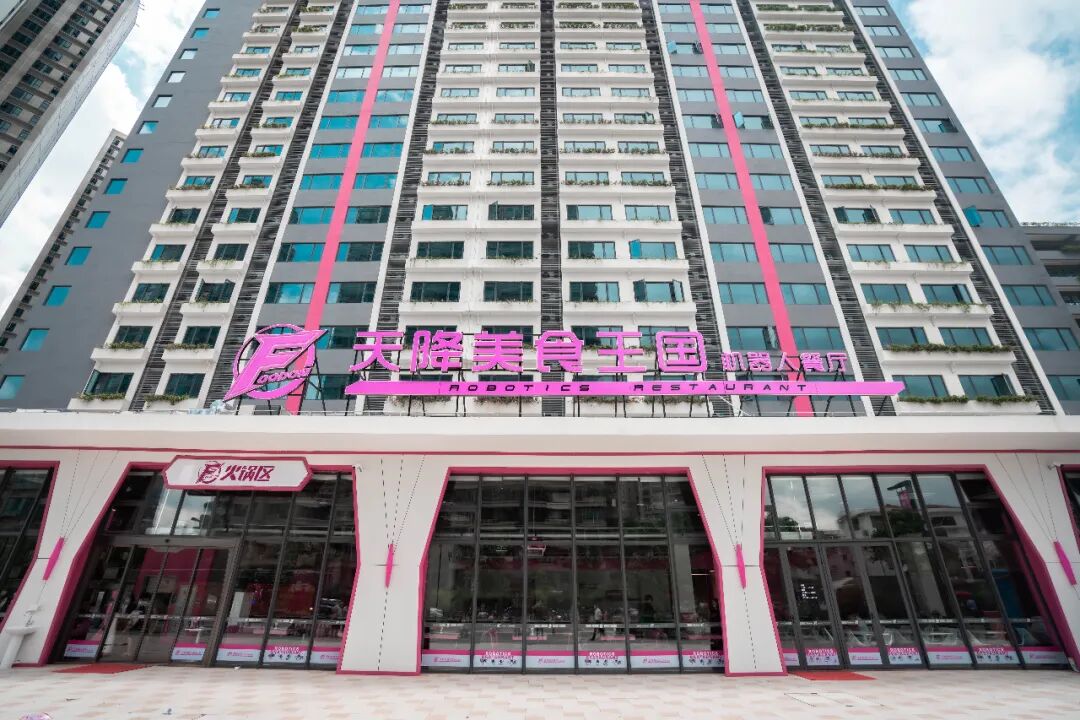
On that day, this FOODOM robot restaurant showcased over 20 types of catering robots developed by Qianxi Robot Catering Group (hereinafter referred to as “Qianxi Group”), including clay pot rice robots, frying pan robots, and fried chicken robots, covering three forms of cuisine: Chinese food, fast food, and hot pot.
It is reported that in 2020, Qianxi Group plans to mass-produce about 5,000 single-unit robots. Qiu Mi, Assistant President of Country Garden Group and General Manager of Qianxi Group, introduced that the robot restaurant will also expand its scale through self-operated, joint venture, and franchise models.
Qianxi Robot Catering Group’s Deputy General Manager, Xiao Ran, stated that the “unmanned and contactless” setup of the robot restaurant meets the demand for “hygiene and isolation” during dining in the pandemic while reducing labor costs, providing new ideas for the development of the catering industry after the pandemic.
1
“Upgraded” Restaurant
Compared to the FOODOM robot restaurant located in Zhujiang New Town, Guangzhou, which opened in January, the newly opened robot restaurant has undergone a comprehensive upgrade:
It has a larger area, increasing from 400 square meters to 2000 square meters, with over 40 catering robot devices in operation, capable of serving 600 people simultaneously; the menu is more diverse, not only featuring frying pan robots and clay pot rice robots but also hot pot robots, and the efficiency of the hamburger robot has been improved from 45 seconds per unit to 20 seconds per unit; the service format is more diverse, including not only dine-in but also trialing takeout services.
Xiao Ran introduced that before the pandemic, the FOODOM robot restaurant in Zhujiang New Town, Guangzhou, could achieve a daily revenue of 60,000 yuan; after the pandemic, the robot restaurant, like all other restaurants, faced limited customer flow and insufficient dining traffic.
“But our losses seem less significant compared to other restaurants because our labor costs are lower,” Xiao Ran analyzed.
Previously, Qianxi Group conducted market research indicating that 88% of consumers, upon entering a restaurant, limited their interactions with staff to ordering, settling bills, pouring water, retrieving utensils, guiding, and recommending. “All these needs can now be addressed through voice services,” Xiao Ran said.
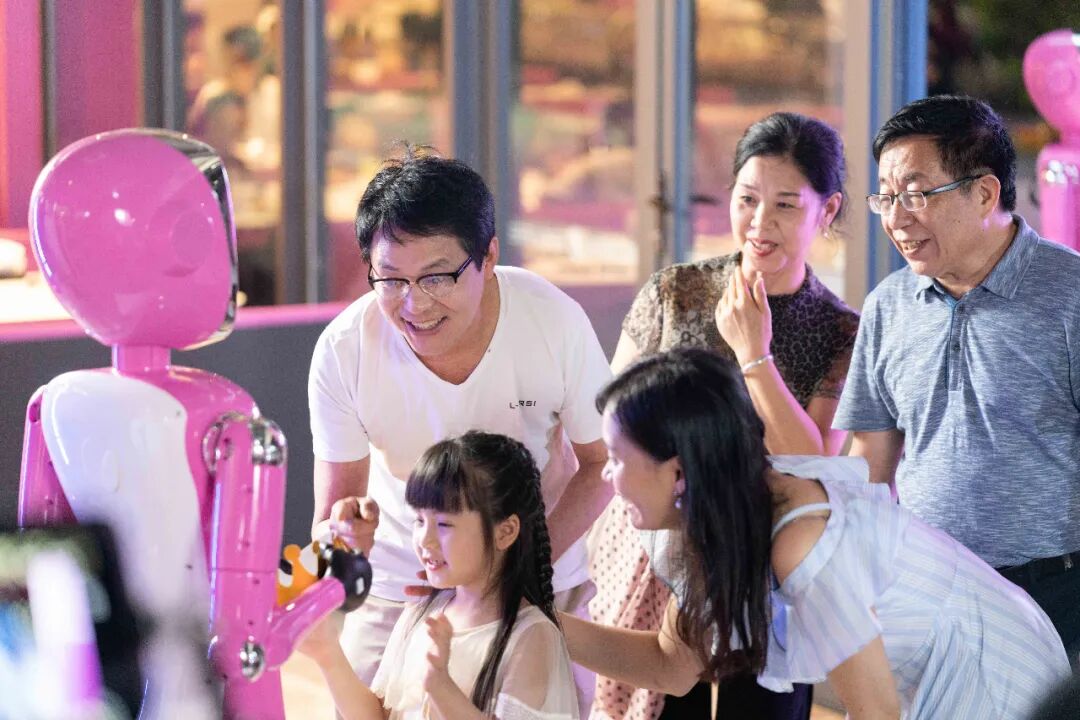
▲ Welcoming Robot
He analyzed that by introducing robots into the catering industry, not only can the industry reduce labor costs, but also the “hygiene and safety” concerns of consumers can be addressed.
It is reported that the current robot restaurant operates under a “central kitchen” model, where in the processes of raw material procurement, cleaning, sorting, semi-finished product processing, packaging, storage, transportation tracking, and cooking, the chances of food contamination caused by manual operations can be minimized through traceability and automated processing. Except for special procedures like killing fish, chopping chicken, and making handmade fish skin dumplings, most dishes can be prepared by machines.
2
Satisfying Public Tastes
“Convenient, fast, and popular is the future positioning of robot restaurants,” Xiao Ran introduced.
Currently, the dishes produced by the robot restaurant mainly focus on stir-frying. The clay pot rice robot can simultaneously prepare 24 portions of clay pot rice, and the hamburger robot controls the preparation time of each hamburger to 20 seconds per unit. In the future, they hope to improve the preparation speed to 5 seconds per unit. “For those busy at work and unable to eat, ordering in five minutes after going downstairs is a future application scenario for robots,” Xiao Ran said.
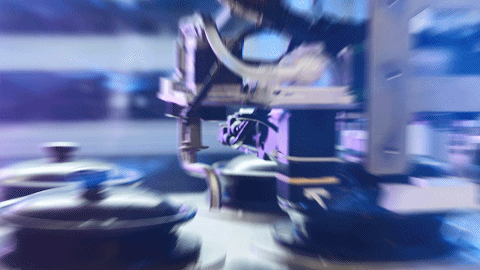
▲ Clay Pot Rice Robot
“Stable and uniform.” Ma Huiliang, the dish development director of Qianxi Robot Catering Group, commented on the dishes produced by robots.
Ma Huiliang introduced that the dish development team controls every aspect from procurement to presentation. Engineers input the processes, steps, and ingredient ratios required for each dish into the program, and the robots are responsible for production and presentation.
Previously, several renowned chefs in Shunde suggested that as the number of chefs decreases, it is a reasonable idea to fix classic dishes and use robots to inherit them. Renowned Shunde chef Lin Chao also expressed his agreement, particularly hoping that his skills could be passed down, and using robots to continue this heritage is very reasonable.
However, Ma Huiliang also admitted that the current team can only achieve the “0 to 1 stage.” In the future, there is still greater potential for robots in dish development and flavor adaptation. “But the current dishes can already present about 90% of our capabilities,” Ma Huiliang said.
Although the dishes produced by the robot restaurant undergo a “double-blind test” during the tasting phase before being launched, making them nearly indistinguishable from those produced by chefs, they still cannot achieve personalized choices for customers regarding saltiness, spiciness, and other preferences. Dai Xianglu, Assistant General Manager of Qianxi Robot Catering Group, hopes that future iterations of the robots will meet these diverse customer needs.
“We have also calculated the calorie values of each dish and hope to present its calories and nutritional elements in the restaurant in the future. We even hope to implement a scanning system to assess each customer’s physical condition and provide product recommendations, allowing everyone to eat more accurately and healthily,” Dai Xianglu said.
3
Finding the Optimal Technical Solution
How to support the changing demands of future dining?
Dai Xianglu introduced that the robot research and development team he is part of has nearly 400 people, accounting for nearly 40% of Qianxi Group’s personnel. Over the past two years, the team has also collaborated with various universities on scientific research, having initiated over 80 projects in the patent application and application development of catering robots, with more than 500 patent applications submitted.
Currently, each robot applied in the restaurant has its core technology. “The control and communication between humans and robots is the core of technology application,” Dai Xianglu explained. The core of the R&D team is to discover the “optimal solution” for the arrangement of different components and structures, finding the most cost-effective solution. “The rent for each square meter of a restaurant is vastly different from that of a factory. Therefore, improving the efficiency of robots can pave the way for the scaling of catering robots,” he said.
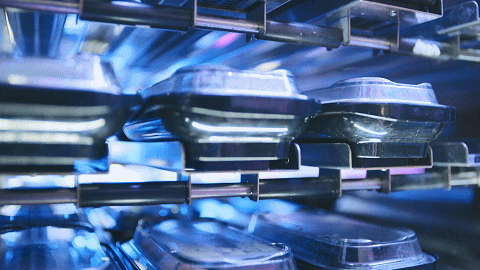
▲ Smart Hot Pot Ingredient Robot
Why is change necessary?
A catering industry insider introduced that the traditional catering industry in China is still a labor-intensive industry, facing high turnover rates, low standardization, low management efficiency, and high operating costs, limiting the space for consumer benefits. The future development of the catering industry will focus on digitalization, intelligence, and refinement upgrades.
According to the “2019 China Robot Industry Development Report” released by the China Electronics Society, the service robot market in China maintained a growth rate of around 30% in 2018, significantly higher than the growth rate of industrial robots. The demand for robots in the catering industry is also continuously rising.
At the beginning of 2019, Country Garden began to layout its three main businesses: real estate, modern agriculture, and robotics. Industry insiders view the opening of the FOODOM robot restaurant complex as an important milestone for Country Garden’s entry into the high-tech field.
Xiao Ran introduced that the preliminary research and development of intelligent dining by Qianxi Group has already shown a “leading trend.” “The accumulated patents and data have become valuable resources.”
In recent years, the clay pot rice robot, ice cream robot, and hamburger robot developed have all achieved mass production in 2020. “More cooperative enterprises, exhibitions, and scenic spots are starting to order robots from us,” Dai Xianglu said.
4
Is Intelligent Dining the New Trend?
Although currently, personalized service remains a feature and highlight of many catering enterprises, the catering industry is also reflecting on the high operating costs dominated by rent and labor after the pandemic.
According to the “2019 Annual Report on the Top 100 Chinese Catering Enterprises and Analysis of the Top 500 Catering Stores” released by the China Cuisine Association, the pressure of labor in the catering industry continued to increase in 2019, with the growth rate of labor costs and rent costs exceeding the sales profit margin of the top 100 catering enterprises, with labor costs becoming the fastest-growing item in catering operating costs, reaching 24.4%, and rent costs growing at 14.4%. The report analyzes that optimizing restaurant cost structures and reshaping the catering industry chain have become issues that more and more practitioners in the catering industry are beginning to consider after the pandemic.
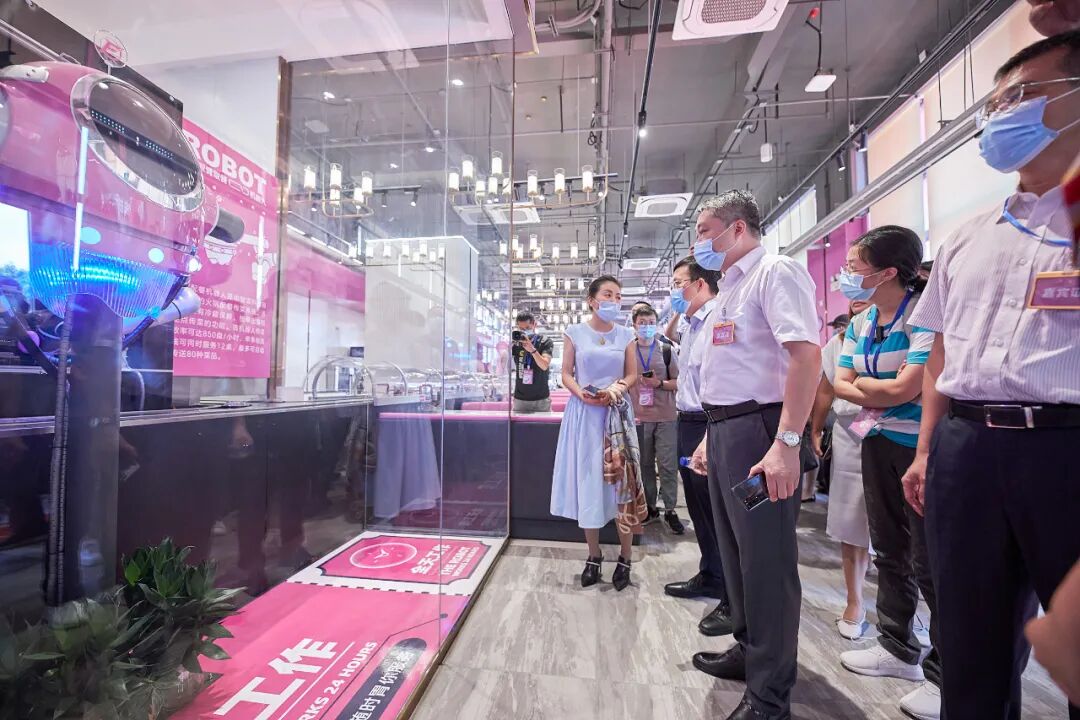
▲ On June 22, the opening of the Food Kingdom Robot Restaurant, guests visited the exhibited robots
In addition to Qianxi Group’s robot restaurant, some companies are also beginning to pay attention to intelligent dining: Ele.me’s affiliated company, Shanghai Lazars Information Technology Co., Ltd., publicly added an authorized patent named “A Device for Adding Condiments and a Stir-Frying Machine,” while Haidilao has increased the number of its intelligent restaurants in Beijing to 10.
Jiang Junxian, President of the China Cuisine Association, stated that after the pandemic, the technological concepts in the catering industry will be enhanced. In the future, the support of technology for the catering industry will also increase. With the deep application of mobile internet, the model of using intelligence to reduce labor costs and relying on standardization to reduce risks will lead the innovative development of the industry and accelerate the development speed of leading enterprises. Intelligent stir-frying machines, robot delivery, fully self-service unmanned restaurants, and other intelligent operating methods will increasingly appear in catering services.
It is reported that the catering robots supplied by Qianxi Group in the future will be applied in public areas such as hotels, scenic spots, hospitals, communities, schools, and office buildings; the offline FOODOM robot restaurant will focus on three main business formats: Chinese food, fast food, and hot pot; in addition, the group will also provide overall solutions for the intelligent transformation of traditional dining spaces for government agencies and large enterprise canteens to meet the needs of unmanned delivery, robot cooking, and standardized production in the post-pandemic era.
(Special Topic)